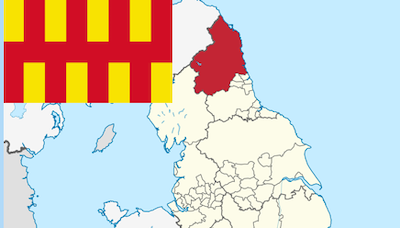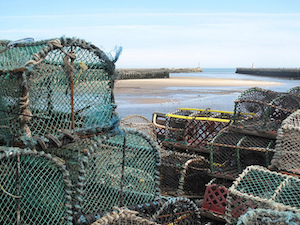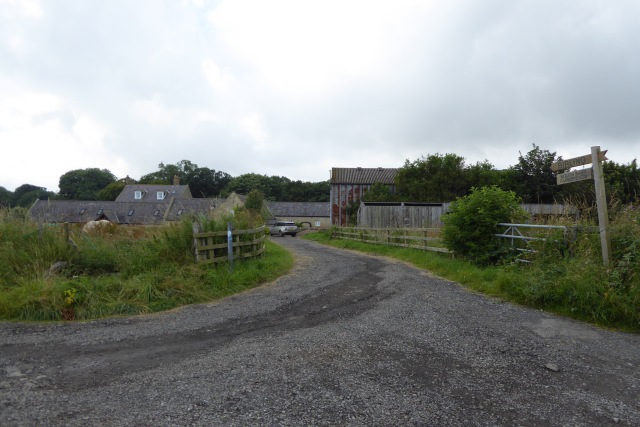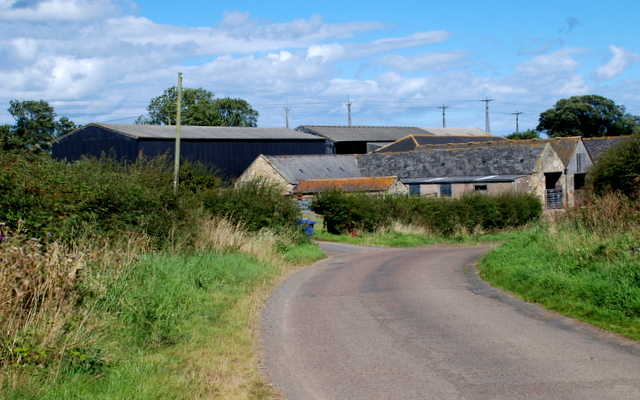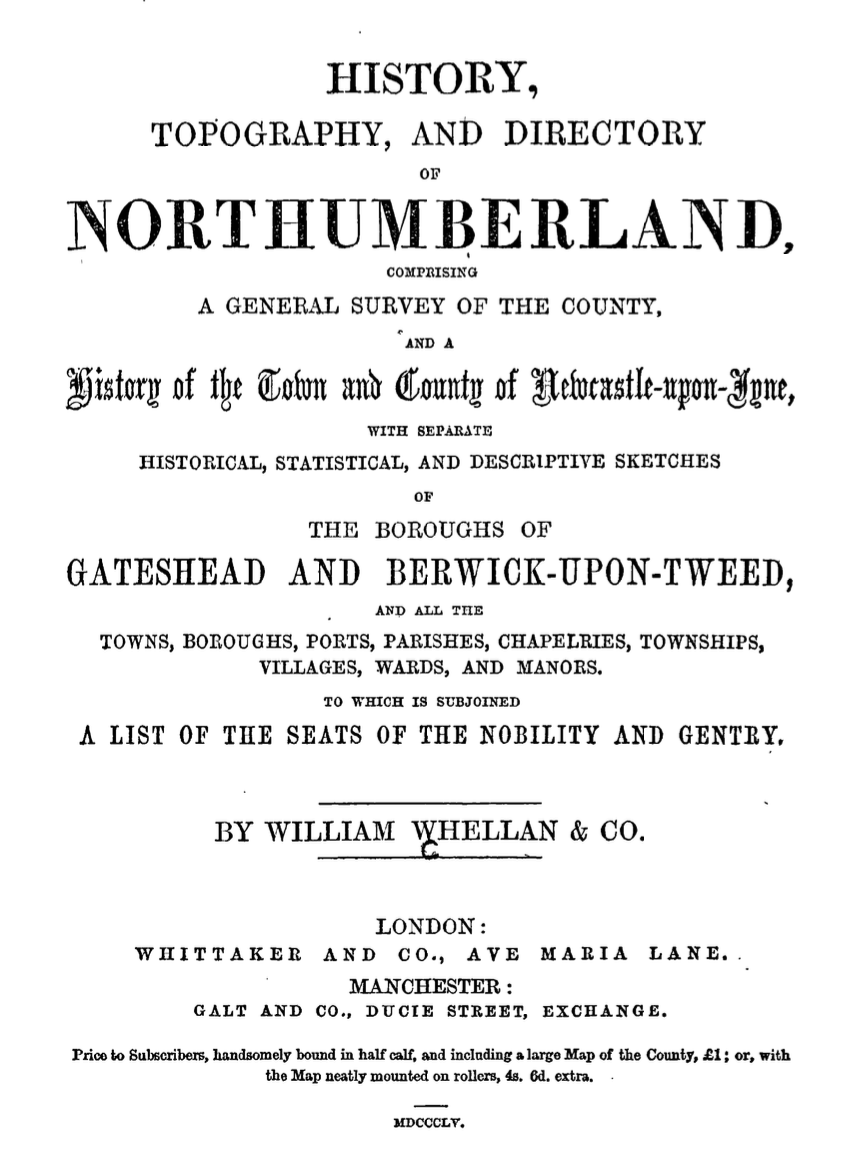Topics > Northumberland > Civil Parishes in Northumberland > Warkworth Civil Parish > Warkworth Parish, 1855
Warkworth Parish, 1855
Extract from: History, Topography, and Directory of Northumberland...Whellan, William, & Co, 1855.
WARKWORTH PARISH
WARKWORTH, a parish in the eastern division of Morpeth ward, and eastern division of Coquetdale ward, comprises eighteen townships, and is bounded on the north by Shilbottle and Lesbury parishes, on the west by Felton, on the south by Widdrington, and on the east by the German Ocean. The parish contains an area of 19,365 acres ; its population in 1801, was 2,033; in 1811, 2,101; in 1821, 2,265; in 1831, 2,478; in 1841, 3,512; and in 1851, 4,439 souls. It is intersected by the river Coquet and by the Newcastle and Berwick railway. The scenery in this district is very beautiful, and gems and pebbles of great value are sometimes found in the bed of the Coquet. It abounds with coal and freestone ; limestone is also found, and there is a valuable whinstone dyke at Acklington.
ACKLINGTON is a township and village the property of the Duke of Northumberland. The area of the township is 2,072 acres, and its annual value £2,282 7s. The number of its inhabitants in 1801, was 2.37; in 1811, 249; in 1821, 269; in 1831, 285; in 1841, 301; and in 1851, 284 souls. THE VILLAGE of Acklington is situated three and a quarter miles S.S.W. of Warkworth, and has been much improved during the last few years, many handsome cottages in the early English style having been erected by the lord of the manor. There is a temporary chapel here in which the Rev. Dixon Brown, M.A., officiates, and a school and teacher's house have been erected. The school is attended by ninety children, though it only possesses accommodation for eighty. John Fish and Miss Ann Fish, teachers. Here is a station on the Newcastle and Berwick railway.
POST OFFICE, RAILLWAY STATION. Frederiek King, postmaster. This is the general post, and money order office for Amble, Felton, Widdrington, and Warkworth. The mails arrive here from the south at 8-20 a. m., and from the north at 4-20 and 9-45 p.m.
|
Bell John, carrier Cowens Ralph and Thomas, coal owners Cowens Robert, shopkeeper Dawson Thomas, boot and shoemaker Dryden William, vict. and blacksmith, Three Horse Shoes Egdell John, vict. Railway Hotel Fish John, schoolmaster Huntley John, vict. and grocer, Plough Inn Huntley William,joinerand builder, (John Huntley and Son King Frederick, station master & postmaster |
Pringle William, boot and shoemaker Purvis Mary, shopkeeper Thomson & Co. woollen manufacturers, Acklington Mill Thomson James ( Thomson and Co.), farmer
Farmers Cowens William, Acklington Coal Houses Egdell John, Railway Hotel Gregory William, Whirley Shaw Richarci.son Henry and Edmund, Chester House Scott James, Acklington Field Thompson Thomas Harper, Cavil Head |
ACKLINGTON PARK, a township and hamlet in the above parish, contains 766 acres, the property of the Duke of Northumberland. Its population in 1801, was 108; in 1811, 125; in 1821, 125; in 1831, 107; in 1841, 133; and in 1851, 104 souls. The rateable value is £686 12s. Id. THE HAMLET of Acklington Park occupies a secluded situation, on the south side of the Coquet, three and three-quarter miles south-west by west of Warkworth. Here is a woollen factory. Acklington High Park, about half-way between Acklington and Felton, is situated on a delightful eminence south of the Coquet.
DIRECTORY. George Appleton, farmer, Acklington High Park; John Field, shopkeeper; Robert Freeman, shopkeeper; John McKcnzie, woodman; and William Thomson (Thomson & Co. ).
AMBLE, a township and village in Warkworth parish, comprises an area of 1,142 acres, and its annual value is £2,546 16s. The number of inhabitants in 1801, was 152; in 1811, 155; in 1821, 197; in 1831, 247; in 1841, 742; and in 1851, it had increased to 1,040 souls. THE VILLAGE of Amble occupies a fine situation near the mouth of the river Coquet, one mile south-east by south of Warkworth ; and from the British and Roman remains which have been found in the neighbourhood, it appears to have been a place of some consequence in early times. There was formerly a monastery here subordinate to the priory of Tynemouth, and its ruins, along with those of the chapel connected with it, are still visible. Amble is advantageously situated on an eminence commanding a view of the sea, and during the last few years, several good inns and houses have been erected. It is expected that when the new docks, now in course of erection, are completed, this village will become a flourishing harbour, and a place of some importance,
POST OFFICE, AMBLE.-Isabella Sanderson, postmistress. Letters arrive, from Acklington, at 10-30 a.m., and are despatched thereto at 2-45 and 6-45 p.m.
|
Bell Andrew, farmer Bell Joseph, tailor Carr Francis, coal agent Chambers Andrew, chemist and druggist Chapman Isaac, coastguard Clayton John, ship captain Coulthard William, slater Currie Margaret, straw-bonnet maker Ditchbnrn James, carver Duncan William, surgeon, Amble House Hepplewaite Thomas, harbour master Henderson John, plumber, &c. Hindmarsh John A. gentleman |
Jackson Hemy, coastguard Johnston John, shipsmith Knox Rev, William (Independent) Muers John, master mariner Nichol John, superintendent of coastguard Pigg Charles, coal trimmer Potts John, schoolmaster Richardson Andrew, custom-house officer Smith F. coastguard Spence William, coastguard Turnbull Thomas, ship chandler Tweedy William, tailor Whittield Edward, coal agent and clerk to the commissioners of Warkworth Harbour |
|
Boot and Shoemakers Duncan John Hall William Horn Richard
Butchers Graham Richard Melrose Richard Shotton James
Drapers Marked * are also Tailors. Dryden Robert * Forster William * Mclnnis nonald Sanderson Isabella Richardson Andrew *
Grocers & Provision Dealers Beaty George Beaty George Coker George Gray Frances Hutchinson Joseph Mason George Mclnnis Donald Neir John Pringle John Rowell John Sanderson Isabella Turner John Young Matthew |
Hotels and Public Houses Blue Bell, James Purdy Docks Hotel, Elizabeth Turner Gardeners' Arms, Thomas Carse Harbour Inn, William Grey Masons' Arms, Charles Young Prince Albert, Ralph Graham Railway Hotel, Elizabeth Watson Radcliffe Arms, Joshua Lackey Schooner Inn, Thomas Young Ship Inn, Robert Carse Togston Arms, William Johnston Waterloo Inn, George Hall, and shipowner Welwood Arms, Christopher Charlton
Joiners and Cartwrights Marked* are also Shipwrights. Carr Robert Edgeley Joseph, and boat builder * Gair and Wandless * Richardson G. and K., and builders * Rutherford Andrew |
BIRLING is a township and hamlet in the parish of Warkworth, but locally situated in the eastern division of Coquetdale Ward. It comprises an area of 826 acres, the property of the Duke of Northumberland, and the annual value is £1,240 15s. 0d. Its population in 1801, was 87; in 1811, 81; in 1821, 69; in 1831, 85; in 1841, 80; and in 1851, 73 souls. THE HAMLET of Birling is situated half a mile north of Warkworth.
DIRECTORY. The farmers are MIiss Alice Cramlington; John Leadler, North Side; John Sordy; and Matthew Wilson, West Farm.
BROTHERWICK is also a township in the same parish, and same division of Coquetdale Ward as Birling. It is situated two miles west of Warkworth, and contains 184 acres, the property of the Duke of Northumberland, and Mr. Fenwick. The number of its inhabitants in 1801, was 10; in 1811, 9; in 1821, 10; in 1831, 4; in 1841, 10; and in 1851, 13 souls. Rateable value £610. This township is farmed by Mr. George Tate, of East House.
BULLOCK'S HALL, a township situated five miles south by west of Warkworth, is the property of George Tate, Esq. It comprises an area of 205 acres, and its rateable value is £276 4s. 7 d. Population in 1801, 7 ; in 1811, 22; in 1821, 14; in 1831, 14; in 1841, 19; and in 1851, 20 souls. This township consists of one farm and an old mansion; the farmer does not reside here.
BUSTON (HIGH) is a township and hamlet in this parish, but locally situated in the eastern division of Coquetdale Ward. It contains 706 acres, the property of the Duke of Northumberland, and G. F. Forster, Esq ; and its rateable value is £1,255 1s 0d. The number of its inhabitants in 1801, was 100; in 1811, HO; in 1821, 95; in 1831, 02, in 1841, 100; and 1851, 97 souls. The tithes are commuted for £ 102 5s. 2d., of which the Bishop of Carlisle receives £78 Ss. 8d., and the Vicar of Warkworth £23 15s. 6d. Here is a good stone-quarry which is worked by Mr. Thomas Brown of Warkworth. THE HAMLET of High Buston is situated two miles north by west of Warkworth. BUSTON HOUSE the seat and property of Roger Buston, Esq, is pleasantly situated, about one mile and a half west of the sea.
DIRECTORY. Roger Buston, Esq., Buston House; William Common, vict and millwright, Plough Inn; William Heatley, farmer; and Henry and John Wilkinson, farmers.
BUSTON (LOW) is a township and hamlet in the same parish and same division of Coquetdale Ward as High Buston. The landowners here are Mrs. Anne Appleby, Lieutenant Spoor, the Misses Bourne, and Edward Thew, Esq. The township contains 870 acres, and its rateable value is £2,189. The population in 1801, was 61; in 1811, 72; in 1821, 85; in 1831, 103; in 1841, 115 ; and in 1851, 109 souls. The tithes are commuted for £215 2s. 6d., of which the Bishop of Carlisle receives £143 18s. 5d., and the Vicar of Warkworth £91 4s. 1d. THE HAMLET of Low Buston is situated one mile and three quarters north-west of Warkworth.
DIRECTORY. Mrs. Anne Appleby, Low Buston; the Misses Ann and Fanny Bourne, Buston Barns; Edward Thew, Esq., Shortridge House; and Adam Winter, farm steward, Low Buston.
CHEVINGTON (EAST), a township in Warkworth parish, the property of Earl Grey, contains 2,225 acres, and its rateable value is £3,160. The number of its inhabitants in 1801, was 123; in 1811, 170; in 1821, 207; in 1831, 234; in 1821, 289; and in 1851, 377 souls. The soil is generally a strong loam clay, and excellent coals are obtained at Broomhill Colliery, from which place there is a railway to Amble Harbour. A neat school was erected here about seven years ago by Earl Grey, in which divine service is performed on Sundays, by the Rev. Dixon Brown, of Acklington.
|
Coulson Edward, coal agent Hope David, brick and tile maker Johnson William, banksman Butter John, schoolmaster Scott Ralph, blacksmith Turnbull John, joiner, grocer, and provision dealer |
Farmers Burn William, Broom Hill Straughan John, Woodside Wilson James, and John William, East Chevington |
CHEVINGTON WEST, a township, situated five miles south by west of Warkworth, comprises an area of 1,804 acres, and its rateable value, is £2,389 12s. 7d. The number of its inhabitants in 1801, was 90; in 1811, 101; in 182L, 108; in 1831, 117; in 1841, 67; and in 1851, 104 souls. Earl Grey is lord of the manor, and owner of the soil. West Chevington, East Chevington, Buillok's Hall, and Hadstone townships form a chapelry, but the chapel has been long in ruins. This district is noted for its fine wheat crops, and a portion of the ancient forest of Earsdon is still visible in the neighbourhood.
DIRECTORY. Samud Goodman, farmer.
GLOSTER HILL is a township, one mile S.S.E. of Warkworth, the property of Robert Dand, Esq. Its rateable value is £290; and its population in 1801, was 21; in 1811, 21; in 1821, 31; in 1831,28: in 1841, 18; and in 1851, 45 souls. This township consists of one farm, in the occupancy of the above named gentleman, and is situated on a hill south of the river Coquet.
HADSTONE township is situated three and a half miles south of Warkworth, and contains 1,165 acres, the property of A. J. Baker Cress well, Esq. The number of its inhabitants in 1801, was 68; in 1811, 72; in 1821, 88; in 1831,97; in 1841, 71; and in 1851, 103 souls. Rateable value, £1,224, 13s. Tithes commuted in J 836 : aggregate amount, £22 11s. 3d , vicarial; and £151 1s. 8d., to the Bishop of Carlisle. This township is divided into four farms, two of which are hold by Messrs. J and J. W. Wilson, of East Chevington, the others by John Bell and John Purvis.
DIRECTORY. John Dell, and John Purvis, farmers.
HAUXLEY is a township and hamlet, the property of the Countess of New. burgh, Thomas Rochester, Esq., Mr. Dand, and Captain Widdrington, of Newton Hall. The area of the township is 7 48 acres, and its rateable value £1,485. The population in 1801, was 92; in 1811, 113; in 1821,114; in 1831, 143; in 1841, 157; and in 1851, in consequence of the opening of a new colliery. it had increased to 811 souls. THE HAMLET of Hauxley is two and a half miles south-east of Warkworth, and is inhabited principally by fishermen.
DIRECTORY. Henry M. Dand, Hauxley Park; Henry Hall, farmer; Robert Ditchburn, vict., Plough Inn; and Matthew Lockey, shopkeeper.
MORRICK, OR MORWICK, is a township and hamlet, the property of Lieutenant General Sir John Grey, K.C.B. It contains 734 acres, and its rateable value is £1,368. The number of its inhabitants in 1801, was 59; in 1811, 75; in 1821,72; in 1831, 64; in 1841,70; and in 1851, 70 souls. Tithes commuted in 1839 : aggregate amount £85 3s., due to the Bishop of Carlisle, and £28 8s. to the vicar of Warkworth. THE HAMLET of Morrick is two miles south-west of Warkworth, and was anciently the capital of the barony of the same name. MORRICK HALL is the residence of Lieutenant General Sir John Grey, K.C.B.
DIRECTORY. Lieutenant General Sir John Grev, K.C.B. and J.P., Morrick Hall ; William Guthrie, farmer, Moorhouse; Francis S. Hewitt, farmer; and John Simpson and Co, millers, Morrick Mill.
STURTON GRANGE is a township in this parish, but locally situated in the eastern division of Coquetdale Ward, two and a half miles W.N.W. of Warkworth. It is the property of Matthew Fenwick Esq., Matthew Riddell, Esq., and William Apple by, Esq. ; comprises an area of 1,094 acres, and its rateable value is £1,602. Population in 1801, 88; in 1811, 86; in 1821, 72; in 1831, 88; in 1841, 108; and in 1851, 130 souls. SOUTH SIDE, the seat and property of William Fenwick, Esq., is pleasantly situated about one mile and a half from Warkworth Station.
DIRECTORY William Fenwick, Esq., South Side; Rowden Briggs, farmer, Coalfield; John Carter, station master, Warkworth Station; George Davison, miller; Andrew Ogle, farm-steward, East Field; and Stephen Tate, farm-steward, Grange.
TOGSTONE is a township and hamlet, the property of the Countess of Newburgh, James Dand, Esq, and Thomas George Smith, Esq. The area of the township is 1,063 acres, and its rateable value is £1,587. The number of inhabitants in 1801, was 84; in 1811, 96 ; in 1821, 102; in 1831, 149; in 1841, 151: and in 1851, 217 souls. Tithes commuted in 1839: aggregate amount, £190 1s. 9d. There is a good colliery in this township, the property of T. G. Smith, Esq., of Togstone Hall. It consists of three seams of coal, the third one being eight feet thick, and is connected with Amble harbour by a line of railway.
DIRECTORY. Thomas George Smith, Esq., Togstone Hall; James Dand, Esq , yeoman; Robert Innis, joiner and builder, and yeoman; Thomas Tail, steward; and John and William Watson, blacksmiths.
WALKMILL, a township in this parish, but locally situated in the eastern division of Coquetdale Ward, is two miles W.S.W. of Warkworth. It contains 123 acres, the property of the Duke of Northumberland, and its rateable -value is £226 10s. 3d. Population in 1801, 6; in 1811, 6; in 1821, 13; in 1831, 7; in 1841, 5; and in 1851, 8 souls. This township contains one farm, in the occupancy of Mr. George Coxon.
WARKWORTH is a township and village in the parish of the same name, the property of the Duke of Northumberland. The township comprises an area. of 3,638 acres, and its rateable value is £3,476 10s. Population in 1801, 614; in 1811,568; in 1821, 594; in 1831, 014; in 1841, 785; and in 1851, 834 souls. Notwithstanding the injuries which Warkworth Castle has sustained from the corroding hand of time, and the dilapidations of man, it still presents a better representation of the stronghold of a feudal baron of the fourteenth and fifteenth centuries, than any other castle on the borders. The greater portion of the outer walls, enclosing the castle yard, are yet standing ; and the walls of the keep and its adjoining towers are, for the most part, strong and in comparatively good repair. We possess no direct historical evidence as to the period when, or by whom, this castle was erected ; though, from a return made in 1166, it appears that the castle and manor of Warkworth were, at that time, held by Roger Fitz-Richard, on the tenure of one knight's service. King John confirmed the castle and manor to the son of the above mentioned possessor, on the same tenure. This son dying in 1215, was succeeded by his son; John Fitz-Robert, whose grandson, John, took the surname of Clavering, from an estate belonging to the family in Essex. This John de Clavering ceded his manors of Warkworth, Rothhury, Corbridge, and their appurtenants, provided he died without male issue, to Edward II., in consideration of certain grants of land in Norfolk, Suffolk, and Northamptonshire, which, becoming the property of the Crown, in the beginning of the reign of Edward III., he granted the castle and manor of Warkworth to Sir Henry Percy, Governor of Berwick, in lieu of a yearly allowance of 500 marks, payable out of the customs of that town. From the date of this grant, in 1334, to the present time with the exception of periods of forfeiture, when Warkworth became the temporary property of the Nevilles, the Umfravilles, and the Ogles - the castle and manor of Warkworth have continued in the possession of the Percy family. "The castle of Warkworth," says Mr. Sterhen Oliver, our best northern tourist, in his interesting "Rambles in Northumberland," &c., "stands on the south side of the river Coquet, and about a mile from its mouth, on a piece of elevated ground, steep on the west, but on the north and east, rising from the river-side with a more gentle acclivity. On the south side, where the castle-yard is on a level with the adjacent country, the entrance has been defended by a deep ditch, which was crossed by a draw-bridge. The barbican, or gateway tower, on the exterior south wall, was in the olden times defended by a portcullis, and had been of much greater magnitude than it is at present, the upper part now being much dilapidated. It formerly contained a prison, and the porter's lodgings, with apartments for the constable of the castle over them. Passing through the archway of this tower, in the lower part of which the person who has charge of the castle resides, the visitor finds himself within the castle-yard, an enclosure about 85 yards long from north to south, by 66 broad, and containing rather more than a square acre. To the west of the gateway are the remains of a tower, in which there were formerly a kitchen, buttery, and other offices. This was called the lion tower, from the figure of a lion which still remains over the arch forming the entrance. To the north stands the keep, which is of a square figure with the angles truncated, having a projecting tower of a semi-octangular form on each of its sides, and surmounted by a lofty exploratory turret. A flight of steps leads to the principal entrance, which is in the southern tower. The lower apartments, of which there are eight, have arched stone roof, and are dimly lighted by loop-holes. In the floor of one of these apartments is an opening to a gloomy vault, fifteen feet square, supposed to have been used as a place of solitary confinement for prisoners, and as there are no stairs by which a person can descend to this black-hole, the wretched captives who were confined there must either have been lowered down by means of ropes, or have descended by means of a ladder. From those apartments one large and two smaller staircases lead to the next storey, the former terminating in a spacious landing place, round which stone seats are fixed, and which.has been a sort of ante-room to the great hall. The great hall is 39 feet long and 24 feet wide, and had been about 20 feet high, extending to the roof, which no longer remains. On this floor are various other apartments, all of which, as they are much lower than the great hall, have had others of the same size above them. Hutchinson, the author of a 'View of Northumberland,' recounts with apparent delight the beauties of the prospect from the top of Warkworth Castle, and few persons who have looked upon the same scene, will think the picture which he draws, too highly coloured: ' From hence,' says he, 'the view is so extensive and various, that description eau convey but a very imperfect idea of its members or beauties; to the east and north-east there is a sea prospect, with which you take in all the shore we have traversed, with Dustanbrough and Bambrough Castles at the most distant points of land; the Farn Islands lie scattered like patches on the face of the waters. The port of Alnmouth is q. nearer object, and at a little distance, the mouth of the river Coquet, and Coquet Island with its ruined monastery are seen. To the north you view a rich cultivated country to Alnwick; westward, the banks of the Coquet river, graced with little woodlands, which here and there impend on its winding channel; to the south, you view an extensive plain, inclining towards the sea, crowded with villages and interspersed with woods; the shore indented by many little ports and creeks, the higher grounds are scattered over with many hamlets, churches, and other buildings, mingling with a variety highly pleasing; whilst, in the extreme distance, the different tints of the landscape, arising from various objects, require colours to convey their picture to the mind." The noble proprietor is now ( 854) repairing the east wing, in order that it may be occasionally used as a residence by the family.
THE HERMITAGE of Warkworth is a secluded retreat, romantically situated on the richly wooded banks of the river, about a mile above the castle. It consists of three small apartments hollowed out of the freestone cliff which overlooks the river. Above the doorway are the remains of some letters, now illegible, but which are supposed, when perfect, to have expressed the words, "Fuerunt mihi lacrymae meae panes die ac nocte," "My tears have been my food day and night." The roof is chiselled in imitation of a groin formed by two intersecting arches, and at the east end is an altar surmounted by a niche. Near the altar a recumbent figure of a female is carved in the wall. In an inner apartment there is also an altar, with a vase for holy water cut in the wall. It is uncertain when this hermitage was formed, though probably it is not older than the reign of Edward II. Dr. Percy has celebrated it in a beautiful poem entitled "The Hermit of Warkworth," from which we subject the following stanzas, descriptive of its appearance:-
"And now attended by their host,
The hermitage they viewed;
Deep hewn within a craggy cliff,
And overhung with wood.
And near a flight of shapeless steps,
All cut with nicest skill ;
And piercing through a stony arch,
Ran winding up the hill.
There, deck'd with many a flower and herb,
His little garden stands;
With fruitful trees in shady rows,
All planted by his hands.
Then scoop'd within the solid rock,
The sacred vault he shows;
The chief a chapel neatly arched,
On branching columns rose.
Each proper ornament was there
That could a chapel grace ;
The lattice for confession framed,
And holy water vase.
O'er either door a sacred text
Invites to godly fear,
And in a little 'scutcheon hung
The cross, and crown, and spear.
Up to the altar's ample breadth
Two easy steps ascend,
And near a glimmering solemn light
Two well wrought windows lend.
Beside the altar rose a tomb
All in the living stone,
On which a young and beauteous maid
In goodly sculpture shone.
A kneeling angel fairly carved
Lean'd hov'ring o'er her breast;
A weeping warrior at her feet,
And near to these her crest."
In the advertisement to the poem from which the above extract is taken, Dr. Percy has made some ingenious surmises respecting the founder and the antiquity of this hermitage ; he also informs us that the memory of the first recluse was held in such veneration by the Percy family, that they maintained a priest to reside in the hermitage and celebrate mass in the chapel. This venerable relic of antiquity, so interesting from its age and the beautiful situation which it occupies, is an object of attraction to strangers from all parts of the country.
THE VILLAGE of Warkworth is pleasantly situated one mile west of the sea, and seven miles south-east of Alnwick, on a species of peninsula formed by the river Coquet, which is here crossed by an ancient stone bridge. It consists principally of one street leading from the bridge to the castle, and contains many good houses. There was formerly a market, but it has now fallen into disuse. Fairs are held on April 25th, if a Thursday; if not, on the previous Thursday, and on November 22nd, for horned cattle, shoes, hats, and pedlary. Warkworth is said to be an ancient borough by prescription, and an annual court-leet is held here on the first Wednesday in October, by the Duke of Northumberland, for the election of a borough-reeve, two moorgrieves, three constables, and other officers. THE CHURCH is a very ancient structure dedicated to St. Lawrence, and is said to have been erected about the year 736, by Ceolwulph, king of Northumbria; but the present edifice, which is a handsome building, with a spire about 100 feet in height, has evidently been erected at a later period. Within the church is the monumental figure of a knight, cross-legged, similar to the figures which are commonly said to be those of knights templars. A modern inscription states it to be "The effigies of SIR HUGH DE MORWICK, who gave the common to this town of Wark worth." The living is a vicarage in the archdeaconry of Lindisfarne and deanery of Alnwick, valued in the Liber Regis at £18 5s. 71/2d.; gross income £576. Tithes commuted in 1839, aggregate amount £102 16s. 9d., due to the Bishop of Carlisle, and £77 16s. 2d. to the vicar. Patron, the Bishop of Carlisle. Vicar, Rev. John W. Dunn. the parish register commences in 1676. Near the church-yard are the ruins of an ancient priory, which, according to Tanner, was formerly ''a cell of two Benedictine monks from Durham, for whose maintenance here Nicholas de Farnham, Bishop of Durham, who died A.D. 1257, appropriated the church of Brankeston, which was confirmed by Walter de Kirkham, his successor." The Wesleyan Methodists and the United Secession have places of worship here.
CHARITY. Elizabeth Clutterbuck, in 1743, left £30, the interest of which was to be distributed yearly, on Christmas Day, to such poor as should dwell and have their settlements in the township of Warkworth.
|
Alder Mr. John Bates Mr. William Barker John, draper and grocer Belll Mrs. Dorothy Bilton Mary, vict. Masons' Arms BowiexJohn, surgeon Browell Joseph, boot and shoemaker Brown Thomas, builder Bryson John, joiner and cabinet maker Burn William, quarry owner Cannon John, woodman Castle Joseph, draper and grocer Clutterbuck John, Esq. Cowens Ralph, farmer, Warkworth Barns Cowens Robert, shopkeeper Crawford Captain W. Crisp James, steward, Warkworth Demesne Davison Thomas R., miller, Warkworth Mill Dawson Elizabeth, draper arid grocer Duncan Rev. James, (Presbyterian) Dunn Rev. John, vicar of Warkworth Egdell Eieanor, butcher Farrell William, tailor Forster Mr. George Grieves Miss Charlotte Graham John, joiner Graham Robert, vict. Jolly Sailor Harrison John, clock and watchmaker Henderson Thomas, shipowner Henderson Henry, draper Hewitt George, boot and shoemaker Hildreth William, farmer Jackson Mrs. Margaret Lackenby George, boot and shoemaker |
Langley William, vict. and brewer, Black Bull Mclntyre Peter S. chemist and druggist, and stationer Marshall Mrs. Margery Maugh James, blacksmith Miller Henry, farmer, New Barns Muers Andrew, butcher and flour dealer Muers Mrs. Jessie Frances Muers William, farmer Needy William, stonemason Newton William, agent Nixon Miss Margaret Ormsby A. & Sons, plumbers and glaziers Potts Thomas, vict. Sun Inn Reed Thomas, farmer, Warkworth Barns Robinson George, brewer and maltster Robinson Thomas, farmer Simpson John, miller and flour dealer Stephenson Thomas, tailor Thompson Elizabeth, shopkeeper and saddler Thompson James, shopkeeper Thompson Thomas, inland revenue officer Todd William, vict. Queen's Head Taylor John, joiner and builder Taylor joiner and cabinet maker Taylor Robert, tailor Wake George, farmer Wake George, boot and shoemaker Watson William, blacksmith Wardle Hannah, flour dealer Wardle Robert, butcher Waters James, cabinet maker Welch William, viet. White Swan Wilson Tate, earthenware dealer Younger George, stonemason |
CARRIER,-To Alnwick, Robert Elliott, on Saturday.

